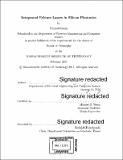Integrated erbium lasers in silicon photonics
Author(s)
Purnawirman
DownloadFull printable version (15.12Mb)
Other Contributors
Massachusetts Institute of Technology. Department of Electrical Engineering and Computer Science.
Advisor
Michael R. Watts.
Terms of use
Metadata
Show full item recordAbstract
We present results on the development of integrated erbium-doped aluminum oxide lasers on a silicon photonics platform. A key achievement in this work is a scalable laser design for high output power and ultra-narrow linewidth performance. Using a novel wavelength-insensitive design, a CMOS compatible waveguide structure is proposed to achieve high confinement factor and intensity overlap for both the pump (980 nm) and signal (1550 nm) wavelengths. Laser operation in the C- and L- bands of the erbium gain spectrum is obtained with both a distributed Bragg reflector and a distributed feedback structure. We demonstrate power scaling with output power greater than 75 mW and obtain an ultra-narrow linewidth of 5.3 t 0.3 kHz. We investigate the influence of gain film thickness uniformity in distributed feedback laser performance and show a compensation scheme based on a curved cavity design. We then consider the application in optical communications by demonstrating a multiwavelength cascaded laser to generate wavelength division multiplexing (WDM) light sources. Finally, we propose an integration scheme of laser in full silicon photonics platform by using an erbium trench. The approach is alignment free and allows the erbium-doped film deposition to be the last backend process, providing a pathway to a scalable CMOS compatible laser device.
Description
Thesis: Ph. D., Massachusetts Institute of Technology, Department of Electrical Engineering and Computer Science, 2017. Cataloged from PDF version of thesis. Includes bibliographical references (pages 109-114).
Date issued
2017Department
Massachusetts Institute of Technology. Department of Electrical Engineering and Computer SciencePublisher
Massachusetts Institute of Technology
Keywords
Electrical Engineering and Computer Science.